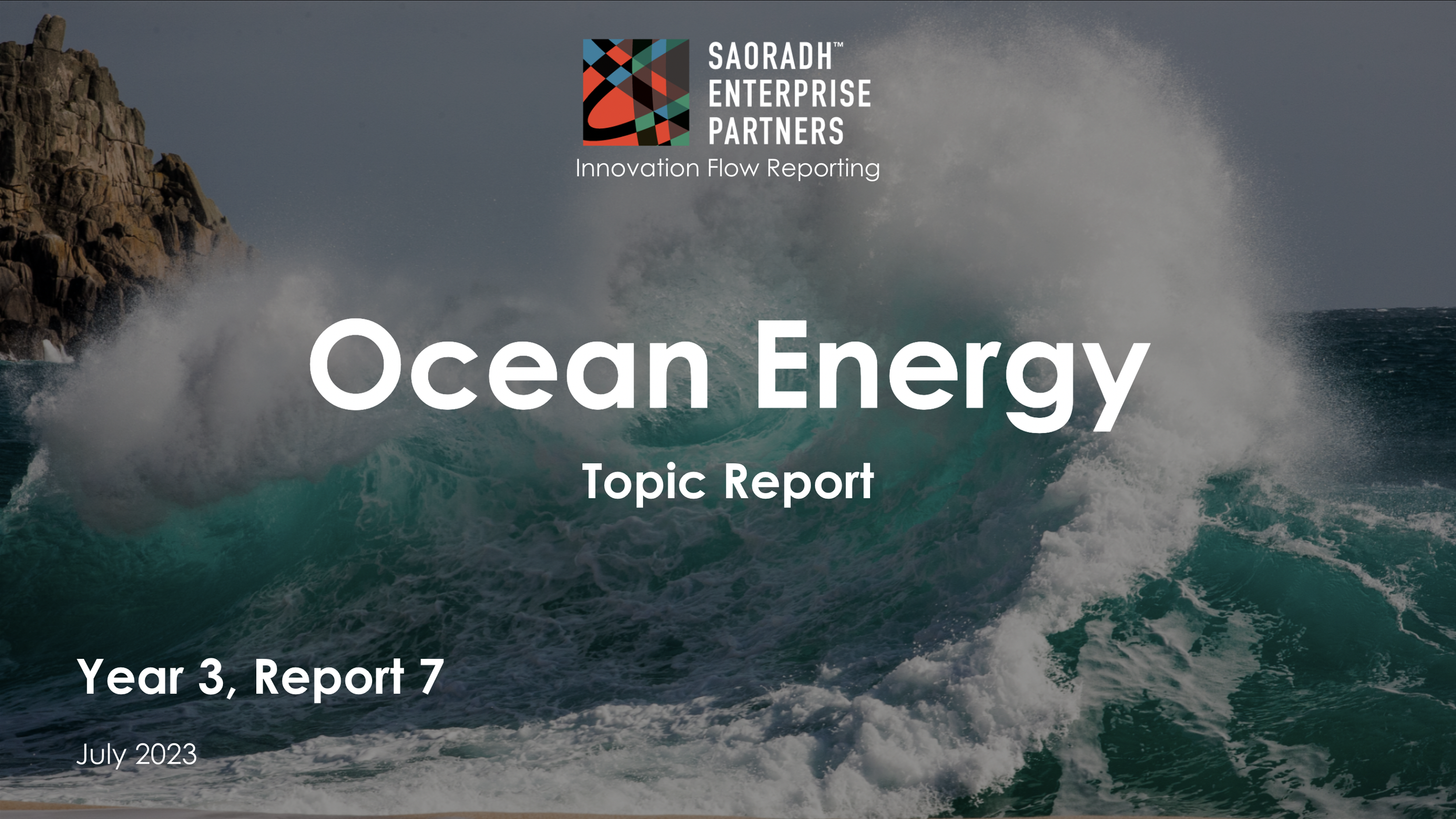Report: Ocean Energy, An untapped resource
Image: Unsplash
Overview
Energy derived from the world’s oceans is evaluated in SEP’s latest IFR Topic Report. Development of energy capture devices for the four types of ocean energy, including tidal, wave, ocean thermal and salinity gradient, are low-to-mid stage TRL and are not yet being produced at scale. Considerable development of technology occurred about 15-20 years ago and recently there has been a resurgence of tech development at research institutions and by startups with notable concentrations in the Northwestern US and Scotland. While current estimates for the cost of ocean energy represent a broad range, the lower end of the spectrum is not far from the cost of large-scale intermittent solar PV with battery storage. Ocean energy has the technical potential to meet a large portion of the global energy needs, has much higher capacity factors (less intermittent) than wind or solar, and exhibits favorable green metrics.
Ocean Energy Definitions
The Ocean Energy Topic Report reviews the four types of renewable energy, which result from the natural movements and characteristics of water in oceans and seas. Tidal energy capitalizes on the rise and fall of seawater due to the gravitational pull of the moon and sun. Wave energy captures the power of ocean waves (which are smaller than tides) that form when wind blows on the surface. Ocean thermal energy leverages the 20℃ difference between the ocean surface and about 1,000 meters ocean depth. Salinity gradient energy generates power using the pressure difference created by the different salt concentrations of seawater and freshwater. The report does not review power derived from rivers or pumped storage.
Drivers
Ocean energy has great technical potential for energy production. In the United States alone, ocean energy could power 54% of the 4,108 terawatt hours (TWh) of energy generated in 2021. From a worldwide perspective, ocean energy could power 100% of the 27,295 TWh of energy generated in 2021, and could power 92% of the projected 83,000 TWh of power estimated to be generated in 2050. On a more practical level, ocean energy could play an important role in complementing solar and wind energy specific to certain geographic locations and energy cost dynamics. A total of 143 startup and growth companies are working in the ocean energy area, which is a notably higher count than for most cleantech segments. Of those 143 companies, 75 focus on wave energy, 37 focus on tidal energy, 9 focus on ocean thermal, and 6 focus on salinity gradient technologies. One reason for the large number of companies developing ocean energy is low embedded greenhouse gas (GHG) emissions footprint. Ocean energy has the second lowest median GHG footprint out of all non-renewable and renewable energy sources according to the National Renewable Energy Laboratory’s Harmonization Study. The technical potential for ocean energy systems to produce the majority of earth's power generation with low GHG emissions offers the opportunity for renewables to be located on both land and the oceans.
Barriers
The ocean energy cleantech segment appears to be struggling to achieving commercial scale. While peer-reviewed research publication counts regarding the four kinds of ocean energy increased in the past ten years, citations for older research decreased. This may indicate that recent research is novel and relies little on previous research, which may indicate a slow pace for commercial adoption. There is also no trend for increasing levels of investment in ocean energy over the past ten years. The investments (capital raised by startup and growth companies) for ocean energy experienced a peak in 2017 and reached the second-highest point in 2021 but have decreased since then.
The biggest barrier to ocean energy is that production costs are higher than most renewable energy alternatives. Wave energy’s levelized cost of energy (LCOE) ranges $0.12-0.47 per kilowatt hour (kWh) and tidal energy’s LCOE ranges $0.13-0.28 per kWh. This is much higher than commercial scale offshore wind’s LCOE of $0.08 per kWh and commercial scale solar PV’s LCOE of $0.05 per kWh. However, given the low intermittency (high capacity factor) for ocean energy it should be compared with wind or solar energy plus energy storage and that is in the range of $0.15-$0.20 per kWh. What is unknown is the cost for any of the four types of ocean energy at a commercial scale comparable to wind or solar energy.
Purchase the Report
A 215 page report in slide deck format complete with references that constitute a comprehensive bibliography of resources on the topic.
A global database of 143 companies (annotated with details about supply chain position, technology type, company size and operating results, employee counts, points of contact, summary of value proposition, invested capital to date, grants received and other details) and the top 20 research institutions.
Analysis of 4 ocean energy technologies, their markets, green metrics, public policy, research and patent trends, and other details.
ABOUT TOPIC REPORTS
Topic reports explore cleantech investment spaces with the aim to calibrate investors, uncover opportunities, and identify possible solutions to Solving Climate+ by 2050. SEP produces topic reports twice per quarter to gather data and insights important to evaluating key cleantech investment spaces as part of our Innovation Flow Reporting (IFR) service. Recent and upcoming reports include BattRe (lithium-ion battery recycling), Biochar, Bioplastics, Clean Food, Concrete and Cement, Desalination, Direct Air Capture, Solar Photoconversion, Green Steel, and Refrigerants.
ABOUT INNOVATION FLOW REPORTING
SEP’s Innovation Flow Reporting (IFR) service is designed to illuminate innovation hubs and identify and capture the best cleantech commercialization opportunities for SEP and our corporate clients. More than just market research, Innovation Flow Reporting delivers actionable information. IFR uncovers new cleantech opportunities for corporate venture capital offices, innovation programs, product development teams, and R&D departments. We know it works because we use it to drive our investing.
ABOUT SAORADH ENTERPRISE PARTNERS
Saoradh Enterprise Partners (SEP) is a cleantech venture capital firm with an in-house research platform that brings a new approach to capturing valuable technologies and building companies. SEP is known for its unique approach, bridging the gap between scientific possibilities, financial viability, industry needs, and environmental sustainability. SEP partners with innovators, entrepreneurs, and corporations to develop cleantech solutions at the intersection of science (what’s possible), finance (what’s bankable), industry (what’s needed), and planet (what matters). We believe that cleantech can succeed in decarbonizing the economy, reducing resource consumption, capturing waste, and preserving biodiversity. SEP is based in Boulder, Colorado and has a satellite office in Sarasota, Florida. Learn more at www.saoradh.com.

